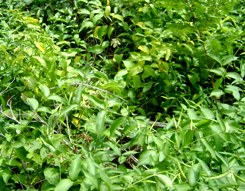Invasive species 101

Dog-strangling vine (Photo by Couchiching Conservancy)
What are invasive species?
Invasive species are plants, animals and other organisms that are not native to an area but have been introduced to it, either intentionally or unintentionally, and harm the ecosystem. Not all non-native species are invasive, but non-native species can become invasive if there are no native predators to control them. They can outcompete native plants and animals and alter how ecosystems function.
Invasive species are one of the most significant threats to global biodiversity after habitat loss.
Why are invasive species harmful?
Invasive species can:
- alter natural habitat and food for wildlife;
- reduce agricultural productivity;
- decrease property value;
- increase costs for maintaining resources;
- are potentially toxic to animals or cause allergies in humans;
- destroy recreational opportunities and the aesthetics of the landscape.
How do invasive species spread?
- in the fur or excrement of livestock and wildlife
- on vehicles, ATVs, snowmobiles, boats
- on the boots of hikers or in the wheels of bikes
- in wind or water
- in contaminated hay or in wildflower and bird seed mix
- as “escaped” ornamental or food plants
- in food imports
What is NCC doing to combat the spread of invasive species?
The Nature Conservancy of Canada (NCC) uses an integrated management approach to managing invasive species on our properties.
Various techniques used include:
- mechanical methods such as pulling or mowing;
- grazing by livestock;
- biological control — using the species' natural predator to combat the invader;
- chemical control by trained professionals.
Depending on the situation, a combination of approaches may be necessary.
In every instance, the situation is studied carefully and options weighed, considering the impact of each method before they it is applied.
Once a strategy is implemented, NCC staff regularly monitor the area to see how effective the strategy is at reducing the population of invasive species and whether new methods may be required.
Did you know?
Every single one of the 200 million European starlings found today in North America are descendants of approximately 100 birds introduced to New York City's Central Park in the early 1890s by a society who wanted to introduce all of the birds mentioned in the works of Shakespeare to North America.
The rapid increase in population sizes of the European starling resulted in the displacement of native cavity nesting birds such as eastern bluebird. Thankfully, while the eastern bluebird was listed as rare for many years, it has since recovered due to bird box programs.
Discover more about invasive species by visiting our invasive species gallery.





